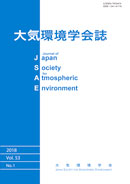
- |<
- <
- 1
- >
- >|
-
Tetsuya Takazawa2018Volume 53Issue 1 Pages pref01_1
Published: January 10, 2018
Released on J-STAGE: March 12, 2018
JOURNAL FREE ACCESSDownload PDF (181K)
-
Jun Matsumoto2018Volume 53Issue 1 Pages 1-12
Published: January 10, 2018
Released on J-STAGE: March 12, 2018
JOURNAL FREE ACCESSOrganic nitrates, ONs, are produced together with ozone (O3) by photochemical reactions in the troposphere. The branching ratio, α, between ONs and NO2 formation after the reaction of NO with peroxy radicals, RO2, can influence the ozone formation. Observations of ONs are insufficient in suburban areas in Japan. In this study, an observation of ONs was conducted at a suburban site in Tokorozawa, Saitama, in the summer of 2015. An analyzer based on the thermal dissociation/cavity-attenuated phase shift (TD/CAPS) method was utilized. Consequently, ONs were successfully monitored for 3 days when total oxidants (=NO2+O3) was 152 ppbv at most. After data filtering by the short-term variation of NO2, the correlation between ONs and total oxidants was explored. Based on the slope of the regression line, α was determined to be 0.04 on average. The branching ratio of ONs formation for the downtown air mass (α=0.05) was greater than that for the suburban case (α=0.02).
View full abstractDownload PDF (1352K) -
Yukiko Fukusaki, Atsushi Ishikura, Junya Hoshi, Akinori Komori, Toru S ...2018Volume 53Issue 1 Pages 13-24
Published: January 10, 2018
Released on J-STAGE: March 12, 2018
JOURNAL FREE ACCESSWe simultaneously surveyed the volatile organic compounds (VOCs) in Yokohama and Tokyo in July and August, 2014 and 2015, and analyzed the changes in the composition of the VOCs before and after the air mass was moved by the sea breeze to determine the VOCs that significantly contribute to the Ox formation in the Kanto region in the summer.
The survey showed that the total concentrations of the VOCs and ozone formation potential (OFP) in Yokohama were higher than those in Tokyo. The compositions of the aldehydes in the OFP were higher in Tokyo. On the other hand, the compositions of the alkanes and aromatics were higher in Yokohama. A comparison of the compositions in the OFP before and after the air mass was moved indicated that there was a common tendency; the OFP of the alkenes and aromatics decreased while the OFP of the aldehydes increased. In addition, as the duration of the air mass movement increased, the increasing rate of Ox went up. The components, such as m,p-xylene, 1,2,4-trimethylbenzene, 1,2,3-trimethylbenzene, and m,p-ethyltoluene, decreased, which suggests that they mostly contribute to the Ox formation in the Kanto region.
View full abstractDownload PDF (1568K)
-
Shinichi Yonemochi, Hiroaki Komatsu, Shinji Saito2018Volume 53Issue 1 Pages A1-A8
Published: January 10, 2018
Released on J-STAGE: March 12, 2018
JOURNAL RESTRICTED ACCESSDownload PDF (616K)
-
Bureau of Environment, Tokyo Metropolitan Government2018Volume 53Issue 1 Pages A9-A17
Published: January 10, 2018
Released on J-STAGE: March 12, 2018
JOURNAL FREE ACCESSDownload PDF (983K)
-
[in Japanese]2018Volume 53Issue 1 Pages A18
Published: January 10, 2018
Released on J-STAGE: March 12, 2018
JOURNAL FREE ACCESSDownload PDF (156K)
-
2018Volume 53Issue 1 Pages N10-N12
Published: January 10, 2018
Released on J-STAGE: March 17, 2018
JOURNAL FREE ACCESSDownload PDF (1219K)
- |<
- <
- 1
- >
- >|